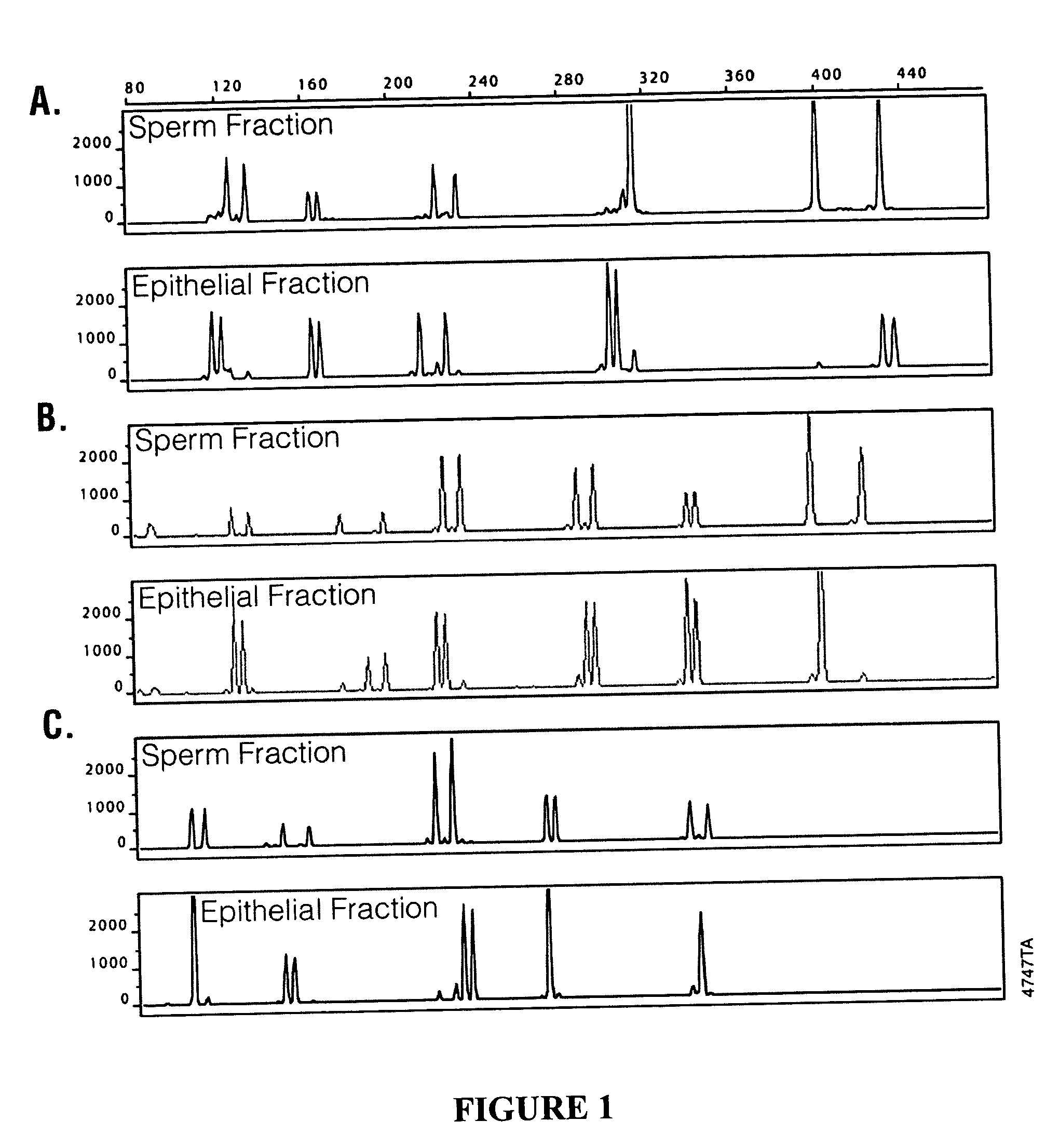Methods and kits for isolating sperm cells
- Summary
- Abstract
- Description
- Claims
- Application Information
AI Technical Summary
Benefits of technology
Problems solved by technology
Method used
Image
Examples
example 1
Isolation of Sperm Cells from Samples Containing Epithelial Cells
[0030] Samples used in evaluating sperm cell isolation included a fresh buccal swab containing added semen, fresh or four year old vaginal samples containing added semen, and a four year old 11-hour post coital vaginal sample. The solid support (e.g., a swab) containing the samples were placed in a microcentrifuge tube. A 0.5 ml aliquot of a digestion solution containing 50 mM NaCl, 10 mM Tris, pH 8.0, 10 mM EDTA, 0.2% SDS, FD&C Yellow dye, and 270 μg / ml Proteinase K was added to each sample. The tubes containing the samples were vortexed for 30 seconds and incubated at 56° C. for 1 hour. Diethyl glutarate and dimethyl glutarate were combined at ratios of 100:0, 50:50, 40:60, 30:70, 20:80, and 0:100 DEG:DMG to form mixed non-aqueous liquids. The ratio of 50:50 formed a liquid with a density of about 1.055 g / cm3. A 100 μl aliquot of the non-aqueous liquid including ratios of 100:0, 50:50, 40:60, 30:70, 20:80, or 0:100 ...
example 2
Isolation of DNA from Sperm Cells or Lysed Epithelial Cells Using Chaotropic Salt and Reducing Conditions
[0032] The DNA from the sperm cell pellet of Example 1 was isolated according to DNA isolation methods described in Promega Technical Bulletin TB296 using components provided in the DNA IQ™ system (Promega Corp., Madison, Wis. Cat. No. DC6701). A 200 μl aliquot of DNA IQ™ lysis buffer containing 4.5 M guanidine thiocyanate (GTC) and 10 mM dithiothreitol (DTT) was added to the microfuge tube containing the non-aqueous liquid and sperm cell pellet, and vortexed briefly to disrupt the sperm cell pellet and to form a homogenous mixture of the non-aqueous phase and the lysis buffer.
[0033] A 7 μl aliquot of DNA IQ™ Resin was added to the solution and mixed by vortexing at high speed for 3 seconds and incubated at room temperature for 5 minutes. The mixture was vortexed for 2 seconds at high speed, the tube was placed in a magnetic stand, and after the paramagnetic resin was attracted...
example 3
Isolation of DNA from Sperm Cells Using a Detergent and Phenol:Chloroform Extraction
[0035] The DNA from the sperm cell pellet of Example 1 was isolated by first removing the non-aqueous liquid to leave a firm sperm cell pellet. A 300 μl solution containing 10 mM Tris, pH 8.0, 1 mM EDTA, 10 mM DTT, and 1% SDS was added to the sperm cell pellet, and the tube was vortexed to lyse the sperm cells and dissolve the DNA. An equal volume of phenol:chloroform (1:1, v / v) was added and vortexed to denature the protein. The aqueous DNA-containing solution was removed, concentrated in a Microcon® apparatus, washed with 200 μl of a buffer containing 10 mM Tris, pH 8.0, 0.1 mM EDTA, and concentrated again in the Microcon® apparatus to about 40 μl. The purified DNA was transferred to a clean container.
PUM
 Login to View More
Login to View More Abstract
Description
Claims
Application Information
 Login to View More
Login to View More - R&D
- Intellectual Property
- Life Sciences
- Materials
- Tech Scout
- Unparalleled Data Quality
- Higher Quality Content
- 60% Fewer Hallucinations
Browse by: Latest US Patents, China's latest patents, Technical Efficacy Thesaurus, Application Domain, Technology Topic, Popular Technical Reports.
© 2025 PatSnap. All rights reserved.Legal|Privacy policy|Modern Slavery Act Transparency Statement|Sitemap|About US| Contact US: help@patsnap.com


